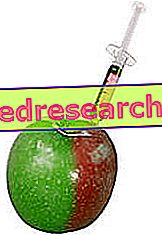Definition
Agitating paralysis, or more correctly Parkinson's disease, is a serious brain degenerative disease, manifested by a heavy impairment of movement, communication and other activities. Parkinson's disease is by far the most frequent pathology of the extrapyramidal system.
Causes
Similar to Alzheimer's disease, even in Parkinson's the cause of origin is still unknown. However, scholars believe that a problem in brain functioning is the predisposing cause; others are convinced that a shortage of dopamine and / or noradrenaline in the brain favors the onset of the disease. Genetic predisposition is a further non-negligible factor.
- Predisposing factors: drinking not perfectly pure water (eg well water), frequent / continuous contact with pesticides / herbicides, exposure to toxins / viruses, age over 60, female sex, living in a rural area
Symptoms
Parkinson's disease is a subtle disease, which generally begins with a slight tremor at the level of the hand, and then gradually spreads to all parts of the body; in Parkinson's disease, the presiding muscles of expressive and cognitive capacity are also involved. Parkinson's disease can also cause marked coordination or total inability to coordinate the various movements.
The most recurrent symptoms are: akathisia, akinesia, altered intellectual capacity (advanced stage) apraxia, bradykinesia, depression, loss of appetite, hypomimia, constipation.
Information on Parkinson's Diseases - Parkinson's Disease Drugs is not intended to replace the direct relationship between health professional and patient. Always consult your doctor and / or specialist before taking Parkinson's disease - Parkinson's disease medications.
drugs
Contrary to what happens for the treatment of Alzheimer's disease, where drugs are scarce and ineffective, a greater number of active ingredients are available for the treatment of Parkinson's disease which, although not able to reverse the disease, can still improve the quality of life of the affected patient. Next to drug therapy, it is recommended to follow a psychological therapy, to practice sports and to eat according to the rules of food education.
Returning to medical therapy, drugs can improve and lighten the symptoms that characterize Parkinson's disease, but they cannot cure the patient definitively. To consider, moreover, that every organism responds in a subjective way to the therapy, therefore it is not said that an effective drug in a patient produces the same terepeutical effect in all the patients; however, it should be emphasized that the initial response to anti-Parkinson's treatment can also be dramatic.
We have analyzed that in the brains of Parkinson's disease a dopamine deficiency is observed: spontaneously one would think that the direct administration of this neurotransmitter could be miraculous. But this is not the case: pure dopamine, in fact, is not able to reach the brain, because it does not pass the blood-brain barrier. In place of dopamine, it is possible to take L-DOPA, its precursor, capable of crossing this barrier and therefore reaching the brain, where it exercises its own therapeutic activity.
It has been observed that Parkinson's disease can be corrected so much the faster the diagnostic assessment and the beginning of therapy are: in fact, the latest generation of therapy aims above all to protect nerve cells, subjected to oxidative insults.
In therapy, in addition to L-DOPA, the most effective drug ever for Parkinson's disease, dopamine agonists, MAO inhibitors, catechol o-methyltransferases, anticholinergics and glutamate blockers are used. Let's look at them in more detail.
Levodopa (eg. Duodopa, Sinemet): this drug is absolutely the most used in therapy for Parkinson's disease, in addition to being the most effective for treating symptoms. When taken orally, the drug is able to cross the blood-brain barrier and, upon reaching the brain, turns into dopamine. Levodopa is always available in association with other active ingredients, such as carbidopa and entacapone (eg Levodopa / Carbidopa / Entacapone orion): carbidopa prevents levodopa from turning into dopamine before reaching the brain (let's remember briefly that the dopamine taken from the outside is ineffective because it fails to pass the BEE). The dosage, however perfected by the doctor, suggests taking at most 7-10 tablets (consisting of 50-200 mg of levodopa and 12.5-50 mg of carbidopa) during the day. Do not administer to patients suffering from severe liver dysfunction. The dosage must be regulated during the course of therapy: typical of this drug is in fact the progressive loss of therapeutic efficacy. The most common side effects include dyskinesias and hypotension.
Dopamine agonists (dopaminergics) : these drugs do not act like the previous one, ie they are not converted into dopamine in the brain; they mimic the therapeutic effects of dopamine, stimulating neurons to react. The administration of these drugs in the context of Parkinson's disease does not prove effective in the long term. Side effects include: hallucinations, hypotension, water retention and drowsiness; Possible obsessive-compulsive behaviors such as hypersexuality, gambling and compulsive eating behavior are also possible.
- Pramipexole (eg Mirapexin, Pramipexole Teva, Oprymea, Pramipexole Accord): for the treatment of Parkinson's disease, it is recommended to administer an oral dose of 0.088 mg, three times a day in the case of immediate-release tablets, or 0.25 mg once a day for prolonged-release tablets. The dosage should be increased gradually every 5-7 days, as long as the side effects can be controlled. Do not exceed three 1.1 mg immediate-release tablets three times a day. When the illness ends, it is recommended to slowly decrease the dosage and not to interrupt the administration abruptly. Consult your doctor.
- Apomorphine (eg Apofin): another dopaminergic agonist indicated to give rapid relief to patients suffering from Parkinson's disease. Before starting therapy it is necessary to test the drug on the patient with a minimum dose (0.2 ml, corresponding to 2 mg); if the drug is tolerated without causing adverse reactions, therapy can be started with a dose of 0.2 ml (2 mg) administered subcutaneously, three times a day. The maintenance dose suggests gradually increasing the dosage (increasing the dose every few days by 0.1 ml = 1 mg), up to a maximum of 0.6 ml (6 mg) per dose. Do not administer the drug more than 5 times a day and do not exceed 2 ml (20 mg) a day.
Monoamine oxidase inhibitors (I-MAO): help prevent the breakdown of natural dopamine (synthesized by the body) and that taken in the form of levodopa. This therapeutic activity is possible through the inhibition of the activity of the monoamine-oxidase B enzymes (enzymes that metabolize dopamine in the brain). Side effects include: hallucinations, confusion, headache, dizziness.
- Selegiline (eg Egibren, Jumex, Seledat): available in oral tablets and in disintegrable tablets. The drug can be taken as 5g oral tablets, twice a day, for breakfast and lunch. For the tablets to be dissolved, you can administer 1.25 mg once a day (preferably at breakfast) for 6 weeks. If necessary, after the first 6 weeks of treatment, the dose can be increased up to 2.5 mg a day. Consult your doctor.
- Rasagiline (eg Azilect): for the treatment of Parkinson's, take a 1 mg tablet a day, with food or fasting. By blocking the enzyme monoamine oxidase-B (responsible for the degradation of dopamine in the brain), the drug is widely used in therapy for Parkinson's disease, in particular it counteracts the rigidity and slowness of movements.
Catecol o-methyltransferase these are drugs indicated to prolong the therapeutic effect of levodopa-carbidopa, interacting and blocking the enzyme that destroys levodopa.
- Entacapone (eg Comtan, Entacapone Teva): widely used in combination with levodopa and carbidopa (eg Levodopa / Carbidopa / Entacapone Orion). It does not cause particular liver problems, although it can cause confusion, dyskinesia and hallucinations. Indicatively, take 200 mg of drug in combination with levodopa and carbidopa, up to a maximum of 8 times a day. The drug can be taken with or without food.
- Tolcapone (eg Tasmar): powerful but extremely dangerous drug for liver damage resulting from its administration. Generally used in those Parkinson's patients who do not respond to previous treatment. Indicatively, take 100 mg of drug three times a day, always in combination with levodopa / carbidopa.
Rivastigmine (eg Rivastigmine Teva, Nimvastid, Prometax, Rivastigmine Actavis): it is a reversible drug inhibitor of acetylcholinesterase, of high pharmacological interest. Start the therapy with rather low drug dosages (1.5 mg, to be taken twice a day, for breakfast and dinner), and then gradually increase them at 2-week intervals, up to 3-6 mg / day. Do not exceed 6 mg twice a day. Also indicated for the treatment of Alzheimer's disease.
Anticholinergics : drugs widely used, for a long time, for the control of symptoms associated with Parkinson's disease (especially tremors). Focusing on the balance between the therapeutic effects (contrasts the tremor) and the side effects (alteration of the memory, confusion, impairment of urination, dry mouth, ocular dryness), we understand how these drugs cannot be used by all patients sick with Parkinson's disease.
- Benztropine (eg. Cogentin): start therapy for Parkinson's disease with a dose of drug ranging from 0.5 to 2 mg, orally, intramuscularly or intravenously, once a day. For the idiopathic form of Parkinson's, take 0.5-1 mg of oral medication once a day in the morning. The maintenance dose can be gradually increased every 5-6 days, up to 6 mg / day.
- Triexiphenidyl or Triesifenidile (es Artane): start therapy for Parkinson's disease with an active dose of 1 mg / day. Increase by 2 mg every 3-5 days. The maintenance dose is expected to take 1 mg a day, increasing the dose - when necessary - from 5 to 15 mg a day, equally distributed in 3-4 doses. Do not exceed 20 mg a day. Reduce the dose when combining other anti-Parkinson drugs: in combination with levodopa, for example, the dose of the drug varies from 3 to 6 mg a day, always divided into several doses.
Glutamate blocking drugs : generally indicated for the treatment of the initial symptoms of Parkisnon's disease. Furthermore, therapy with these drugs is indicated for Parkinson's patients with marked postural changes (dyskinesias), especially if they are derived from the administration of levodopa.
- Amantadine (eg Mantadan): it is a rather weak dopaminergic agonist, with modest antiparkinsonian therapeutic effects: it acts giving relief to tremor and rigidity, but it can generate tolerance, confusion and hallucination. The dosage suggests taking 100 mg a day, to be increased after a week to 100 mg in double daily dose, possibly in combination with other antiparkinson drugs. Do not take more than 400 mg a day. It gives short-term relief in the context of Parkinson's disease
In addition to the administration of the drugs described above, it is possible to follow a parallel therapy for the control of secondary symptoms and to improve the patient's quality of life:
- drugs for the treatment of depression
- medications for the treatment of anxiety
- drugs for the treatment of constipation



